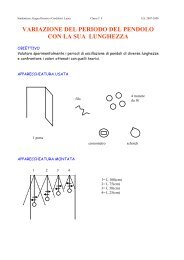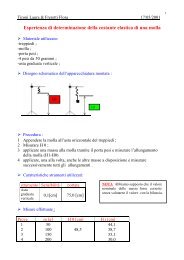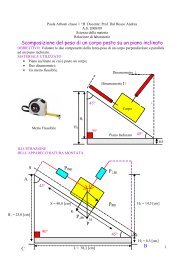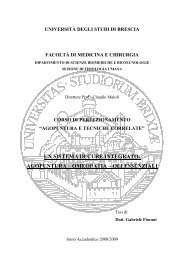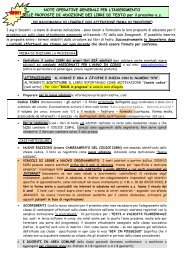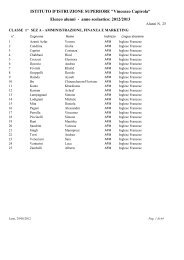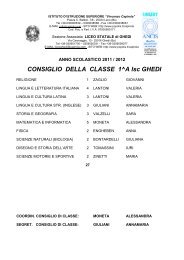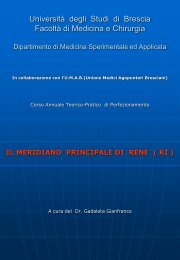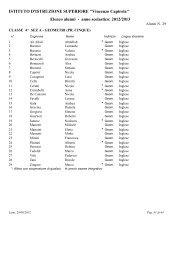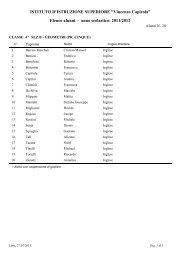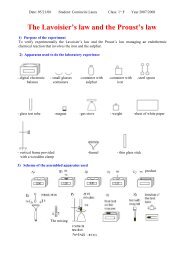Moto uniformemente accelerato con la guidovia - Popolis
Moto uniformemente accelerato con la guidovia - Popolis
Moto uniformemente accelerato con la guidovia - Popolis
You also want an ePaper? Increase the reach of your titles
YUMPU automatically turns print PDFs into web optimized ePapers that Google loves.
GRANDEZZE FISICHE MISURATE<br />
Grandezza Simbolo Unità di misura Strumento<br />
Tempo T [s] Multi-timer<br />
Spazio S [m] Asta graduata<br />
CARATTERISTICHE DEGLI STRUMENTI UTILIZZATI<br />
Strumento Risoluzione Portata<br />
Multi-timer 0,01 [s] >60 [s]<br />
Metro 0,01 [m] 2 [m]<br />
FASI OPERATIVE DELL’ESPERIENZA:<br />
1. Innanzitutto si sono accesi il timer ed il blower e abbiamo cominciato a capire come era<br />
strutturato il sistema.<br />
2. Poi abbiamo misurato lo spazio (∆s) compreso fra due fotocellule che è stato fissato di 40<br />
[cm] e il tempo(∆t)<br />
3. Si è fatta quindi cadere <strong>la</strong> massa (m) attaccata al<strong>la</strong> carruco<strong>la</strong> in modo da dare inizio al moto<br />
dell’aliante che, inizialmente, era stato posto in prossimità del<strong>la</strong> prima fotocellu<strong>la</strong> (Vi=0).<br />
4. Abbiamo riportato in una tabel<strong>la</strong> i tempi registrati dal multi timer effettuando 5 prove di<br />
ri<strong>la</strong>scio dell’aliante in modo da ottenere risultati più attendibili dei tempi.<br />
5. Con i tempi e gli spazi percorsi riportati in tabel<strong>la</strong>, si sono calco<strong>la</strong>te le velocità e le<br />
accelerazioni in vai punti.<br />
6. Abbiamo infine tracciato tre grafici (spazio-tempo, velocità-tempo e accelerazione-tempo)<br />
allo scopo di visualizzare meglio i risultati ottenuti e per capire anche visivamente se erano<br />
stati commessi degli errori.<br />
TABELLE RELATIVE AI DATI RACCOLTI ED ELABORATI<br />
Tabel<strong>la</strong> n°1<br />
n° prove T1 [s] T2 [s] T3 [s] T1med. [s] T2med. [s] T3med. [s]<br />
0 0,00 0,00 0,00<br />
1 1,15 0,51 0,40<br />
2 1,15 0,51 0,39<br />
3 1,15 0,52 0,39 1,15 0,52 0,39<br />
4 1,15 0,52 0,39<br />
5 1,13 0,52 0,39<br />
Tabel<strong>la</strong> n°2<br />
Ttot. med.i Si ∆ti ∆si Vi ∆ti ∆vi ai<br />
[s] [m] [s] [m] [m/s] [s] [m/s] [m/s 2 ]<br />
0,0 0,000 - - - - - -<br />
1,15 0,400 1,15 0,400 0,35 - - -<br />
1,78 0,800 0,52 0,400 0,77 0,52 0,42 0,81<br />
1,90 1,200 0,39 0,400 1,02 0,39 0,25 0,64<br />
FORMULE UTILIZZATE PER ELABORARE I DATI:<br />
Ti med. = (T1i+T2i+…T5i)/5 [S]; ∆Ssi = Si-Ssi-1 [m];<br />
T1 tot = T1 [s] Vi = ∆Si/∆Ti [m/s];<br />
T2 tot = T1+T2 [s]; ∆Vi = Vi-Vi-1 [m/s];<br />
T3 tot = T1+T2+T3 [s]; ai = ∆Vi/∆Ti [m/s 2 ].<br />
∆Ti = Ti-Ti-1 [s];<br />
4



